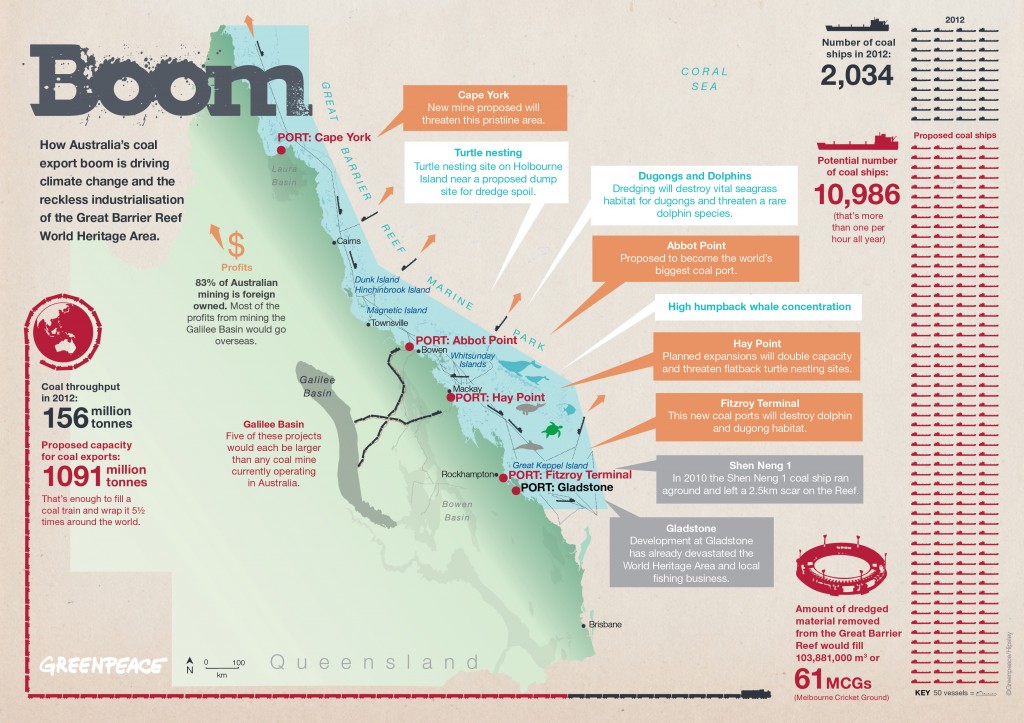Sometimes we need to advocate to protect places from new ‘development’ proposals, before the damage has been done. The challenge here, for environmental activists and for designers, is to make the future impacts of a proposal feel real and tangible and to create a sense of urgency to act, before the bulldozers move in. Designer Sarah Hipsley, from Greenpeace Australia Pacific, tells us how she is working to do this to stop the worlds biggest coal port from being built in the middle of the Great Barrier Reef.
I have been working on a campaign opposing proposals for nine mega mines and mega ports which, if implemented, could more than double Australia’s coal exports, devastate the climate and result in the world’s biggest coal port right in the middle of the Great Barrier Reef.
It’s easy with hindsight to wonder how environmentally devastating proposals are allowed through in the first place. But before this kind of destruction happens it’s incredibly hard for people to visualise the impacts and scale of the destruction, and all the devastating flow-on impacts − on local fishing, farming and tourism industries, on the water table, on health and local communities − not to mention the increase in ships, shipping incidents and oil spills, many of which are simply impossible to imagine. People care about the environment and the places they love and do want to protect them, but often they take action when the damage is done, when it’s too late, because it’s only then that they understand the loss. The real challenge is getting people to care before it’s too late.
Over the past 18 months, the challenge for me, as designer for Greenpeace Australia Pacific, has been to visualise the proposed mines, rail, ports and underwater dredging, as well as the contribution all this will make to climate change. The point of these visuals has been to inspire people to care about these proposals and motivate them to take action to stop them.
Through focus groups and other research we discovered that people weren’t really aware of what was going on and so we realised we needed to find a way to get our message out and educate people on the issues. Because there was no real footage linking the coal boom with the Reef and climate change and because the story was very complex, I decided an animation would work best to communicate our message. I wanted the animation to be sharable, engaging and informative – and so we went for a narrative with humour and rich graphics that aimed to enrage people enough to act, whilst empowering them by directing them to take action.
We also created a website where people could sign a petition, learn more about the campaign, contact politicians with influence (via email, phone or Twitter) and opt to become more involved. I wanted the imagery in the website to be really impactful and show the beauty of the Reef alongside the threat of the dredging, ports and ships – which we had discovered were the things people were most concerned about. In a crowded marketplace, immersive images are key to drawing people in and creating an emotional link to get people to care – because it’s outrageous to think places like the Great Barrier Reef might be destroyed.
This infographic was an effective educational tool, conveying the size and scale of the proposals in simple graphical terms. With the quantity of coal from the proposed mines filling coal trains, wrapped around the world and an army of ships waiting off the coast, Queensland looked like it was under attack and the contrast between the current development and the proposals became obvious. Because this infographic helped to visualise the key elements of the proposals and the damage they would cause, it was picked up by both the Australian and International media.
The graphic below was created in the lead-up to one of the many campaign deadlines. It worked incredibly well because the graphic is easy to understand. It also worked because it conveys a sense of urgency – and people are much more likely to act under pressure. The quote was also strong and adding a reference to a credible source created validity.
The battle to save the Reef and stop Australia’s relentless coal export boom is ongoing. We’ve come a long way since this campaign launched, but we still have a long way to go and we will continue to fight for people’s attention, to motivate and mobilise them so these proposals stay as just that: proposals.
Additional Resources:
Sarah Hipsley’s design can be seen here on her personal website.


